Cosmetic poisoning is not an alarmist!
Nail polish and cleansing oil are two things that women can't do without, but can you think that lipstick nail polish remover can really be fatal? According to reports, a female employee used a cleansing oil to poison the boss's water glass. It is not known whether the "poisoning" will succeed. However, these cosmetics do have great harm in daily use!

Cosmetic poisoning is not an alarmist!
makeup remover:
As a cleaning product, the main component of cleansing oil is the oil that can dissolve makeup. It also contains a small amount of surfactant so that the soiled oil mixes with the water and is washed away. In addition, there are some auxiliary ingredients, such as preservatives, spices and so on. These ingredients are not only found in cleansing oils, but also in a variety of cosmetics and even topical ointments.
They are safe during normal external use. After all, before the product went on the market, various toxicological tests were started from the raw material link, covering all aspects of oral toxicity and genotoxicity. When cleaning, you may accidentally put the product into your eyes and cause stinging. A few times will not have any effect, but you should try to avoid it. Due to the different configurations, the eye mucosa is much more fragile than the skin. It is not only painful to get into cosmetics, but also other inflammations.
Lipstick and lip gloss:
Lipstick and lip gloss are essential "love weapons" for beauty. Most lipsticks and lip glosses are made with oil as a base and supplemented with pigments. Since the lips are also mucous membranes rather than the skin of the stratum corneum like the face, the cosmetics applied to the lips have stricter safety standards than eye shadows.
What the public is most concerned about is whether there will be heavy metals such as lead and mercury in the lipstick. It can be said that legitimate products are not deliberately added to them. The little residue left in the product is accidentally introduced during the production process, and there is really no way to get rid of it. What is this "a little bit"? The standard in mainland China is that the lead content should not exceed 40 mg/kg, the mercury content should not exceed 1 mg/kg, and some countries in the United States and Canada have lower limits. China's reference water standard is less than 0.001mg/kg of mercury. Considering that a lipstick of about 5g can be used for at least 50 days, the amount of mercury that is exposed from lipstick every day is less than the amount of water we drink every day. The comparison of lead content is also reasonable. Therefore, there is no need to worry about qualified products.
Those who use lipstick to make lipsticks are even more nonsense. Most people will wipe them off before drinking and eating, which is a practice worth promoting. The various ingredients of the lipstick are not beneficial to the human body, and may also absorb various pollutants floating in the air because of the richness of oil.
Nail polish:
Nail polish is the most repelled beauty. Regardless of whether the taste is pungent, most nail polishes contain a variety of organic solvents such as acetone, ethyl acetate, toluene, and the like. These solvents can cause irritation to the skin, mucous membranes, etc., and most importantly, may affect various systems in the body. At this point, the nail polish also has the same problem.
In addition, plasticizer phthalates (such as DBP) that may be present in nail polish may have an adverse effect on the reproductive system due to an estrogen-like effect. However, the use of qualified products can basically guarantee the safety of consumers. The content of certain toxic substances is strictly limited, and the minimum amount of use and good ventilation can reduce the risk. In addition, more and more manufacturers have 3F (3 Free, which means no acetone, toluene, DBP), which increases product safety. Although some people may be allergic to ingredients such as acetone, this is an individual case.
But the two groups need special attention to nail polish: pregnant women and manicurists. Oil-soluble organic solvents are more likely to pass through the placental barrier than water-soluble ones, while developing fetuses are particularly sensitive to toxic substances. In particular, DBP may affect the development of its reproductive system. Although no official agency (such as the US Food and Drug Administration) said that nail polish is not suitable for pregnant women, it is necessary to use it carefully, such as reducing the frequency of use, ventilation of windows, use of nail stickers containing less toxic volatiles or water-based nail polish. . Manicurists face greater risks. They often come into contact with nail polish all day in a poorly ventilated small room, and the products used are not necessarily qualified - the unqualified products may contain benzene or more cheap materials such as toluene or ethyl acetate. In addition, heavy metals may exceed the standard.
Food Waste Disposers,Kitchenaid Garbage Disposal,Food Waste Processor,Food Waste Disposal
Ningbo Ifilter Purification Equipment CO.,Ltd. , https://www.aifilterparts.com